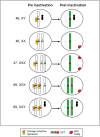Embryonic loss of human females with partial trisomy 19 identifies region critical for the single active X
- PMID: 28403217
- PMCID: PMC5389809
- DOI: 10.1371/journal.pone.0170403
Embryonic loss of human females with partial trisomy 19 identifies region critical for the single active X
Abstract
To compensate for the sex difference in the number of X chromosomes, human females, like human males have only one active X. The other X chromosomes in cells of both sexes are silenced in utero by XIST, the Inactive X Specific Transcript gene, that is present on all X chromosomes. To investigate the means by which the human active X is protected from silencing by XIST, we updated the search for a key dosage sensitive XIST repressor using new cytogenetic data with more precise resolution. Here, based on a previously unknown sex bias in copy number variations, we identify a unique region in our genome, and propose candidate genes that lie within, as they could inactivate XIST. Unlike males, the females who duplicate this region of chromosome 19 (partial 19 trisomy) do not survive embryogenesis; this preimplantation loss of females may be one reason that more human males are born than females.
Conflict of interest statement
Figures



Similar articles
-
X inactivation in triploidy and trisomy: the search for autosomal transfactors that choose the active X.Eur J Hum Genet. 2008 Feb;16(2):153-62. doi: 10.1038/sj.ejhg.5201944. Epub 2007 Oct 31. Eur J Hum Genet. 2008. PMID: 17971834
-
Inducible XIST-dependent X-chromosome inactivation in human somatic cells is reversible.Proc Natl Acad Sci U S A. 2007 Jun 12;104(24):10104-9. doi: 10.1073/pnas.0610946104. Epub 2007 May 30. Proc Natl Acad Sci U S A. 2007. PMID: 17537922 Free PMC article.
-
[Establishing transcriptional silencing of the X chromosome during early embryogenesis].Biol Aujourdhui. 2010;204(3):199-204. doi: 10.1051/jbio/2010013. Epub 2010 Oct 13. Biol Aujourdhui. 2010. PMID: 20950563 French.
-
Choosing the Active X: The Human Version of X Inactivation.Trends Genet. 2017 Dec;33(12):899-909. doi: 10.1016/j.tig.2017.09.005. Epub 2017 Oct 5. Trends Genet. 2017. PMID: 28988701 Review.
-
The eXceptional nature of the X chromosome.Hum Mol Genet. 2018 Aug 1;27(R2):R242-R249. doi: 10.1093/hmg/ddy148. Hum Mol Genet. 2018. PMID: 29701779 Free PMC article. Review.
Cited by
-
A Meta-Analysis of Brain DNA Methylation Across Sex, Age, and Alzheimer's Disease Points for Accelerated Epigenetic Aging in Neurodegeneration.Front Aging Neurosci. 2021 Mar 11;13:639428. doi: 10.3389/fnagi.2021.639428. eCollection 2021. Front Aging Neurosci. 2021. PMID: 33790779 Free PMC article.
-
Escape From X-Chromosome Inactivation: An Evolutionary Perspective.Front Cell Dev Biol. 2019 Oct 22;7:241. doi: 10.3389/fcell.2019.00241. eCollection 2019. Front Cell Dev Biol. 2019. PMID: 31696116 Free PMC article. Review.
-
Paircounting.Trends Genet. 2019 Nov;35(11):787-790. doi: 10.1016/j.tig.2019.07.010. Epub 2019 Sep 12. Trends Genet. 2019. PMID: 31521404 Free PMC article.
-
Examining Sex Differences in the Human Placental Transcriptome During the First Fetal Androgen Peak.Reprod Sci. 2021 Mar;28(3):801-818. doi: 10.1007/s43032-020-00355-8. Epub 2020 Nov 4. Reprod Sci. 2021. PMID: 33150487
-
Gene regulation in time and space during X-chromosome inactivation.Nat Rev Mol Cell Biol. 2022 Apr;23(4):231-249. doi: 10.1038/s41580-021-00438-7. Epub 2022 Jan 10. Nat Rev Mol Cell Biol. 2022. PMID: 35013589 Review.
References
-
- Russell LB. Another Look at the Single-Active-X Hypothesis. Trans N Y Acad Sci. 1964;26:726–36. - PubMed
MeSH terms
Grants and funding
LinkOut - more resources
Full Text Sources
Other Literature Sources
Medical

